
|
|

June 16, 2006
WCAP 980, Lowell, Massachusetts
By SCOTT FYBUSH
Here at Tower Site of the Week, we tend to suffer somewhat from "shoemaker's child" syndrome - we're quick to jet across the country to get pictures of the latest tower construction in Los Angeles or the newest studio in New York. We're not always so good, however, at profiling the studios and transmitters that have been most important in your editor's own professional life, though.
Fortunately, events intervene sometimes - like, for instance, the 55th anniversary on June 10 of WCAP (980) in Lowell, Massachusetts, the station that launched your editor's career in radio news. The station's current news director, Gary Francis, and former talk host Bill O'Neill spearheaded a nifty reunion. A decade and a half after first sitting down behind the WCAP microphone, your editor finally got to see the station's transmitter. And that means you get to come along, as well...
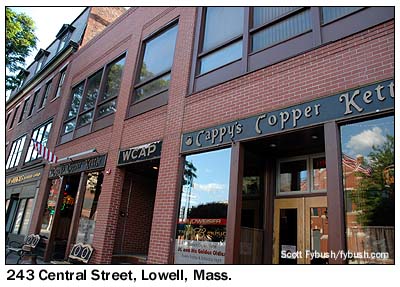 |
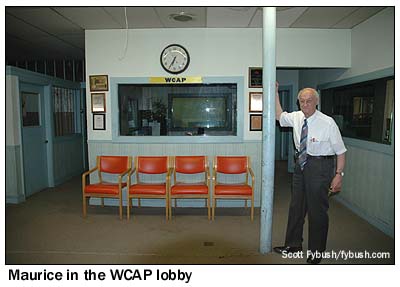
|
Before we get to the June 2006 transmitter visit, we start with some studio pictures from a June 2005 visit to Lowell - and before that with the very simple history of WCAP. The station signed on June 10, 1951, as a 1000-watt non-directional daytimer on 980, from studios on the second floor of 243 Central Street. The studios have never moved; the power was increased to 5 kW DA-2 in 1979 - and from day one until today, the station has been under the same ownership. It was put on the air by Ike Cohen and his brothers Maurice and Ted, and with the deaths of Ike and Ted, Maurice remained as sole owner.
The WCAP studios today look almost exactly as they did when your editor first climbed the stairs there in 1991, and based on the pictures on display at the reunion, they looked about the same in 1971, too. The room directly behind Maurice in the photo above was being used as an office on my latest visit; in earlier incarnations, it was a conference room and, before that, the home of an early tape-based automation system. Down the hall behind him is the entrance to the main air studio, shown below at left.
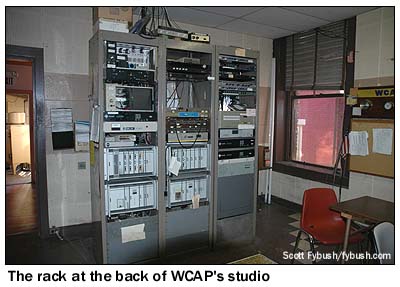 |
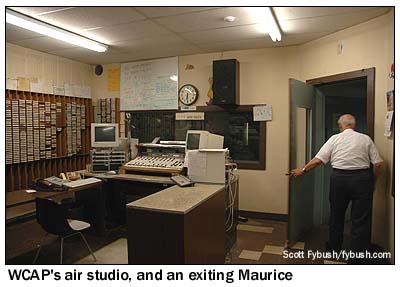 |
There's some seriously defunct equipment in the rack at the back of the main air studio (SEDAT receiver, anyone?) - but that's nothing compared to the two rooms behind the studio. There's an old record library, and beyond that a big room where most of the gear from WCAP's long history is still carefully stored. And look carefully through the doorway - that's the legendary old fridge with the compressor on top, no longer in use but still in working condition, according to Maurice. (You can't quite see it in this picture, but I'm pretty sure the sign in front of the air talent with the call-in phone number - 458-9123 - has had the area codes "617" and then "508" carefully covered up over the years; it's now "978.")
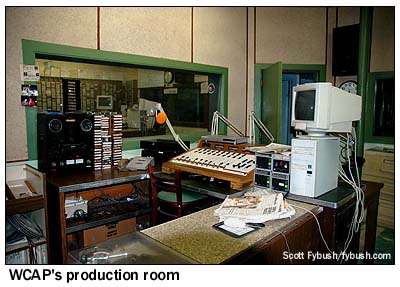 |
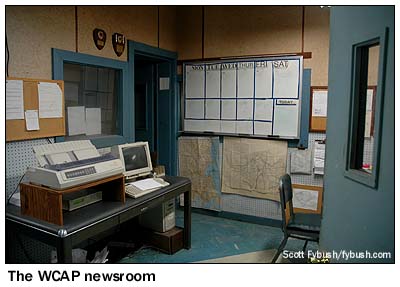 |
Sitting at the main air console, you'd look to your right to see into the production room, shown above at left. (The production board, in turn, faces into the old conference room/automation room.)
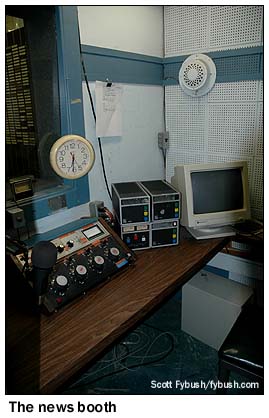 Looking
straight ahead from the main air console, the air talent (like
Bill O'Neill, the Saturday-morning talk host during your editor's
Saturday-morning news days way back when) would look straight
ahead into the little news booth shown at left. The microphone
has been replaced since 1991, and the computer monitor on the
right is new, but everything else here is just as it was back
then. (That old speaker on the wall almost certainly goes right
back to 1951!)
Looking
straight ahead from the main air console, the air talent (like
Bill O'Neill, the Saturday-morning talk host during your editor's
Saturday-morning news days way back when) would look straight
ahead into the little news booth shown at left. The microphone
has been replaced since 1991, and the computer monitor on the
right is new, but everything else here is just as it was back
then. (That old speaker on the wall almost certainly goes right
back to 1951!)
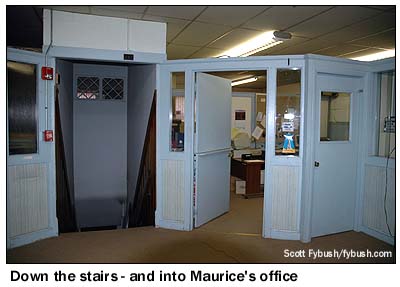 There's
another little news booth behind this one - that's the door you
see in the newsroom picture above - and a newsroom big enough
for two people to work in. Not shown here is the window between
the newsroom and the main studio, where a homebrewed row of light
bulbs indicated various bulletin levels from the UPI newswire.
There's
another little news booth behind this one - that's the door you
see in the newsroom picture above - and a newsroom big enough
for two people to work in. Not shown here is the window between
the newsroom and the main studio, where a homebrewed row of light
bulbs indicated various bulletin levels from the UPI newswire.
The rest of the facility - the part facing the front, towards Central Street - consists of offices, with Maurice and Ike getting the big windows facing the street. (The studio window, by contrast, looked out on a dingy alley behind the building.)
Alert readers will note that the walls to most of these offices don't actually reach to the ceiling. At least back in 1991, when fax paper was relatively expensive, the station's lone fax machine was locked up in one of these offices, and the story goes that at least one intrepid weekend newsperson climbed up and over the wall to retrieve an urgent fax that had come in. (No, it wasn't your editor - and the truth of the matter is that Ike, by then well into his eighties, was likely to be in the station almost as early as the news guy on many Saturday mornings.)
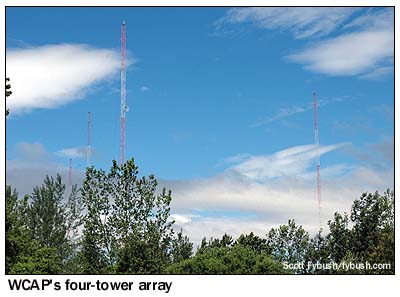 |
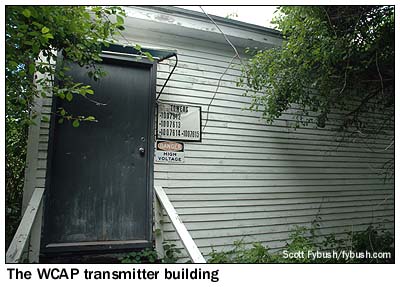 |
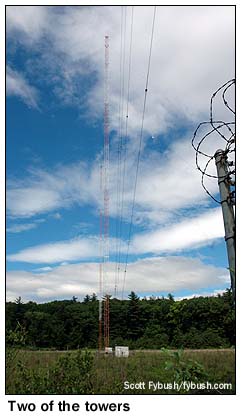 So
that's the studio - and perhaps at least a partial explanation
for your editor's romance with old-time radio facilities. Now,
let's cross the Merrimack River north and west into Dracut, heading
for Totman Street and the four-tower directional array that the
Cohens built in 1979 to take their station to full-time status.
Built right at the edge of the Lowell-Dracut State Forest, the
WCAP towers are each 250 feet tall, well-painted and lit.
So
that's the studio - and perhaps at least a partial explanation
for your editor's romance with old-time radio facilities. Now,
let's cross the Merrimack River north and west into Dracut, heading
for Totman Street and the four-tower directional array that the
Cohens built in 1979 to take their station to full-time status.
Built right at the edge of the Lowell-Dracut State Forest, the
WCAP towers are each 250 feet tall, well-painted and lit.
(Maurice says they were built especially thick to provide good bandwidth for AM stereo, which seemed like a very real possibility in 1979. The station never did go stereo, and when asked about using that bandwidth to go IBOC digital, Maurice laughed pretty hard.)
The array sits in swampy land, and after the very rainy spring of 2006, there was so much standing water out there that it was impossible to walk beyond the first tower, which is itself reached by walking down an overgrown trail from the transmitter building.
By day, WCAP uses the two widely-spaced towers facing Totman Road - the two rightmost towers in the photo above - putting out a pattern that aims the signal more or less north, albeit with almost no directionality.
At night, those three towers at left form an in-line, end-fire array aiming the entire signal southeast over Lowell and down towards Boston, with deep nulls to co-channel 980 signals in Troy and Quebec City, though the latter station is now defunct.
(In the early nineties, WCAP signed off overnight, and upon walking into the studios early in the morning, one was greeted with the sounds of WTRY in Troy blasting from the air monitor in the back room!)
Inside the little transmitter building, there's a nice row of equipment consisting of the phasor (built by CSP in Pennsylvania), the Harris MW-5 main transmitter (purchased new, like the phasor, in 1979) and the Bauer 707 1 kW backup transmitter that came over from the old daytime-only site. (Unlike most Bauers, which were built on-site from kits, Maurice says this one was bought off the NAB show floor fully assembled sometime in the seventies.)
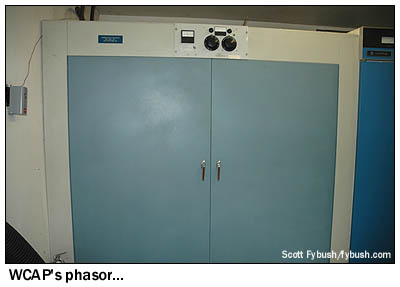 |
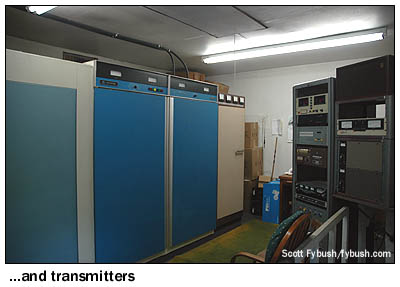
|
That comfy-looking rocking chair next to the processing racks (including an Optimod that certainly wasn't there in 1991!) backs up to a stairway that leads down to the basement of the transmitter building, where an emergency generator sits.
And there you have it - what may well be the station under the longest continuous individual ownership anywhere in the country. Happy 55th anniversary, WCAP - and here's to many more, Maurice!
|
STILL HERE - BUT WE NEED YOUR SUPPORT: If you're a fan of the national radio message-board sites, you're probably feeling a little disoriented lately by all the changes they're going through. (We are, too, though we've pretty well settled on the new radioinsight.com as the friendly spot to talk about all things radio and TV.) Here at fybush.com, we're now in our twelfth year of regular, uninterrupted service to our readers, and we're not going anywhere. Same address, same weekly columns, same old design. (OK, perhaps a few things could use some freshening this year.) And if we've learned anything after all those years in the radio website business, it's this: good things don't come for free. Or at least when they do, they don't last forever. But thanks to our loyal subscribers and our growing fleet of advertisers, we've built a solid community here. We were here in 1994, we're here in 2006, and assuming there's still a radio dial to cover, we have every intention - with your support - of still being here in 2018. (I wish I could say the same about my hairline.) If you still haven't subscribed yet for this year, do it right now at our Support page - and enjoy another exciting year of Tower Site of the Week and NERW, guilt- (and password-) free. And if you have become one of our many subscribers, thank you! |
- Previous Site of the Week: Terre Haute, Indiana (part II)
- Next Week: Mount Mansfield, Vermont - Under Construction
- Site of the Week INDEX
- How can you help support Site of the Week? Click here!
- Submit your suggestions for a future Site of the Week!
